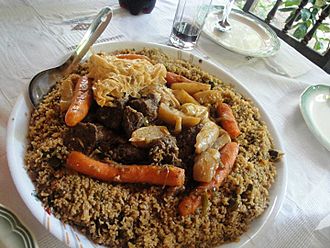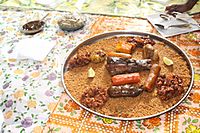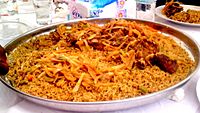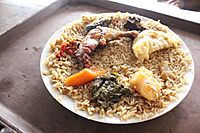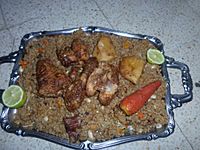Riz gras facts for kids
Riz gras is a tasty dish from Burkina Faso, a country in Africa. It's made mostly with rice and meat. You can also find this popular meal in other African countries like Senegal and Guinea. Riz gras got its start from a Senegalese dish called tiebou djen, which is also a rice dish but often includes lots of fish and meat.
Riz gras is a hearty meal that's often served at parties and special gatherings in cities across Burkina Faso. It's known for being packed with flavor and lots of good ingredients.
Contents
What is Riz Gras?
Riz gras means "fatty rice" in French, but it's not about being unhealthy! It refers to the rich, flavorful sauce that coats the rice. This dish is a complete meal, often served as the main course. It's a favorite because it's filling and uses fresh, local ingredients.
Where Does Riz Gras Come From?
The idea for Riz gras comes from a famous Senegalese dish called tiebou djen. Tiebou djen is a national dish of Senegal and is known for its mix of rice, fish, and vegetables cooked together in a rich tomato sauce. Riz gras took this idea and made it its own, often focusing more on meat and a slightly different mix of vegetables. It shows how food ideas can travel and change across different cultures in Africa.
What's in Riz Gras?
Riz gras is made with many fresh ingredients that give it its amazing taste. The main parts are rice and a good amount of meat, like beef, chicken, or sometimes lamb.
Here are some common ingredients you might find in Riz gras:
- Tomatoes
- Eggplant
- Bell peppers (like red or green peppers)
- Carrots
- Cabbage
- Onions
- Garlic
- Meat or vegetable broth (for extra flavor)
- Cooking oil
- Salt
All these ingredients are cooked together, often in a big pot, allowing the flavors to mix. The rice then soaks up all the delicious sauce, making it very flavorful.
When is Riz Gras Eaten?
Riz gras is a special dish, often enjoyed during celebrations. In urban areas of Burkina Faso, it's a popular choice for parties, family gatherings, and other big events. It's a dish that brings people together, and serving it shows hospitality. While it's a party food, families also enjoy it as a regular meal, especially on weekends.
Gallery
See also
 In Spanish: Riz gras para niños
In Spanish: Riz gras para niños


